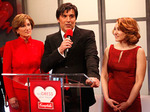
Remember when you had to wait until the commercial break to be bombarded with brand marketing? Probably not, since product placement has been a Hollywood addiction since the 1980s.
Ever since Steven Spielberg featured Reese’s Pieces in 1982’s E.T. (after being turned down by short-sighted M&M reps), brands and content creators have embraced product placement as a sort of commercial symbiosis.
This Wednesday, we’ll be tackling the issue of product placement at #adweekchat, a one-hour Twitter conversation open to all. Join us at 2 p.m. Eastern for a lively discussion of the best, worst and weirdest examples of product placement in TV, movies and video.
In the meantime, enjoy revisiting a few of the more iconic moments of product integration (some paid, some not) that have helped to shape how writers and producers weave brands into their storylines—with mixed results:
Superman vs. Zod vs. Marlboro vs. Coca-Cola (1980)
And don’t forget the KFC box on the dashboard. This classic scene set the stage for 2013’s Man of Steel, which reaped an astounding $160 million from promotional tie-ins with brands like Sears and Warby Parker.
Wayne’s World Makes Pepsi, Reebok and Pizza Hut Part of the Gag (1992)
Looking back on this classic scene, my favorite part is that Rob Lowe never joins them in breaking the fourth wall. He seems earnestly baffled about why these two public-access TV schmucks are so into Pizza Hut and Nuprin.
Get Shorty’s ‘Cadillac of Minivans’ Is Actually an Oldsmobile (1995)
At the very least, you have to appreciate the John Travolta comedy’s commitment to making an awkward product placement (the Oldsmobile Silhouette) into a recurring gag. It popped up throughout the movie as character Chili Palmer’s signature coolness rubbed off on the ride. The original Swagger Wagon, you might say.
30 Rock Brings Back the Meta Humor for Snapple (2006)
This is my favorite product placement in TV history, and I hate Snapple. So much for my chances with Cerie (whose last name, by the way, is Xerox for reasons that are never explained in the show). In addition to the TGS Show’s love of Snapple, Liz Lemon also helped us see the magical splendor of products like Verizon Wireless phones.
Talladega Nights Really Loves Applebee’s, Except for the Rats in the Cobb Salad (2006)
You can almost hear the awkward conversation as the producer had to tell Applebee’s exactly how this lengthy, seemingly glowing scene set in the restaurant was going to play out. Hat tip to Adweek Twitter follower Heather Taylor for the reminder on that one.
Frank Underwood Loves That PlayStation Vita (2013)
Many viewers were bemused by the House of Cards anti-hero’s obsession with the PlayStation 3 and the (rarely seen on Capitol Hill) portable PS Vita. Of course, many brands make recurring cameos on House of Cards. Check out this slideshow of appearances by Apple (oh so much Apple), Blackberry, Canon and more:
The Netflix show’s creators claim they don’t receive financial compensation for product placements, which are provided gratis by the brands. Discussing the PlayStation Vita mention, episode director James Foley told The Guardian, “If we use real products like people do in real life, somehow that’s perceived as being forced-in product placement when it’s just recording reality.”
Hawaii 5-0 Really, Really, Really Loves Subway (2012)
This is the Citizen Kane of product placements, an achievement so gratuitous you almost have to admire it. Although I’m really not sure it makes me want a sub, much less five.
What are some of your favorites? Don’t forget to join us on Twitter at 2 p.m. ET on Wednesday, Aug. 13, for a whole hour of #adweekchat dedicated to product placement.



























 A Saatchi Interactive de Tel Aviv, Israel, está trabalhando na campanha de lançamento da
A Saatchi Interactive de Tel Aviv, Israel, está trabalhando na campanha de lançamento da 




 Fox Television has taken viral marketing to a new level. Everyone should take notice. Spawning from the new hit series Fringe, Fox has launched an ad campaign unlike any seen before. Rather than relying on the staple marketing ploys of late night talk show rounds, standard TV ads and review/word of mouth popularity, Fox unloads a strategy that is both in-your-face and yet somehow subtle.
Fox Television has taken viral marketing to a new level. Everyone should take notice. Spawning from the new hit series Fringe, Fox has launched an ad campaign unlike any seen before. Rather than relying on the staple marketing ploys of late night talk show rounds, standard TV ads and review/word of mouth popularity, Fox unloads a strategy that is both in-your-face and yet somehow subtle.
